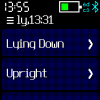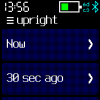Someone suggested I split off a new thread from this other thread for discussing body position tracking specifically, which seems like a good idea.
Chris Armstrong from OMF brought up a device called activPAL a few months ago:
Some info on activPAL: It's a device that is attached to the thigh.


It detects its own physical position in space (is it vertical, horizontal, moving, etc), which translates to the position of the thigh, which translates to the position of the whole body. If the thigh is horizontal, then the person is either sitting or lying down. If the thigh is vertical, the person is standing.
Some research is also done with the device in other locations, like the torso. This paper looked at position tracking with two activPALs at once - one on the thigh, one on the torso. If both are horizontal, the person is lying down. If both are vertical, the person is standing. If the torso is vertical, but the thigh is horizontal, the person is sitting.
ActiGraph is another device used in research for tracking body position and activity:

This seems like a very useful tracking/outcome measure for people with ME/CFS. At least for me, my main symptoms are physical fatigue, cognitive fatigue, and anxiety. They all pretty much go up and down in tandem. With this device, physical fatigue can be tracked continuously and fairly easily.
Step count can be used to measure fatigue, and is fairly easy to track with cheap devices. But at least for me, I don't think I walk much more or less depending on my energy. It's mostly just things I need to do, and I do them whether I have the energy or not (unless I am extremely fatigued): work, grocery store, cooking, and a little bit of walking around the house for hobbies when I have the energy.
In contrast, I think the amount of time I spend lying down, versus reclining/sitting, is a more accurate measure of how much energy I have. The more exhausted I am, the more I need to be lying down. If I'm feeling a little better, I do a little bit of sitting while playing on my phone or interacting with people. (Of course this won't really be applicable to people much more severe than me.)
So I think this would be a useful measure for tracking ME/CFS fatigue or PEM in research, including treatment trials. Something like it might also be useful for personal health tracking, maybe connected to an app like Visible.
Unfortunately, I haven't been able to find any such devices that can be purchased for personal use. Some smartwatches do some sort of body position tracking, but I think it's hard to get an accurate idea of what the body is doing from the position of the wrist. Though maybe I'd be surprised if I looked more into those.
In the thread I linked at the top, I described how I'm trying to build my own device for tracking my body position, though I'm not sure how difficult this project will end up being. It doesn't seem very complicated in principle.
Images from:
1. (Non) occupational free-living physical activity in crane operators and office workers, 2018, Kastelic et al
2. Human Activity Recognition of Individuals with Lower Limb Amputation in Free-Living Conditions: A Pilot Study, 2021, Jamieson et al
3. Using unsupervised machine learning to quantify physical activity from accelerometry in a diverse and rapidly changing population, 2023, Thornton et al
Chris Armstrong from OMF brought up a device called activPAL a few months ago:
We have been trialling these devices called activpal to look at position for the purpose you highlight. https://www.palt.com/why-activpal/
It's the only device we found that is reliable with position. Pretty underrated for this disease and we're doing a mini-trial with an at-home continuous blood pressure device to try capture OI problems in the home for patients. Looking at the feasibility of an all-in-one device for people to track if they might have OI. A lot of healthy people have OI but we never really study this and why is it different with disease but this is a critical question to answer.
Some info on activPAL: It's a device that is attached to the thigh.


It detects its own physical position in space (is it vertical, horizontal, moving, etc), which translates to the position of the thigh, which translates to the position of the whole body. If the thigh is horizontal, then the person is either sitting or lying down. If the thigh is vertical, the person is standing.
Some research is also done with the device in other locations, like the torso. This paper looked at position tracking with two activPALs at once - one on the thigh, one on the torso. If both are horizontal, the person is lying down. If both are vertical, the person is standing. If the torso is vertical, but the thigh is horizontal, the person is sitting.
Conclusion: Despite heterogeneous methodological and statistical approaches, the included studies generally provide supporting evidence that the activPAL can accurately distinguish between sedentary and standing postures. Multiple activPAL monitor configurations (e.g., thigh and torso) are needed to better characterize sitting versus lying postures.
ActiGraph is another device used in research for tracking body position and activity:

This seems like a very useful tracking/outcome measure for people with ME/CFS. At least for me, my main symptoms are physical fatigue, cognitive fatigue, and anxiety. They all pretty much go up and down in tandem. With this device, physical fatigue can be tracked continuously and fairly easily.
Step count can be used to measure fatigue, and is fairly easy to track with cheap devices. But at least for me, I don't think I walk much more or less depending on my energy. It's mostly just things I need to do, and I do them whether I have the energy or not (unless I am extremely fatigued): work, grocery store, cooking, and a little bit of walking around the house for hobbies when I have the energy.
In contrast, I think the amount of time I spend lying down, versus reclining/sitting, is a more accurate measure of how much energy I have. The more exhausted I am, the more I need to be lying down. If I'm feeling a little better, I do a little bit of sitting while playing on my phone or interacting with people. (Of course this won't really be applicable to people much more severe than me.)
So I think this would be a useful measure for tracking ME/CFS fatigue or PEM in research, including treatment trials. Something like it might also be useful for personal health tracking, maybe connected to an app like Visible.
Unfortunately, I haven't been able to find any such devices that can be purchased for personal use. Some smartwatches do some sort of body position tracking, but I think it's hard to get an accurate idea of what the body is doing from the position of the wrist. Though maybe I'd be surprised if I looked more into those.
In the thread I linked at the top, I described how I'm trying to build my own device for tracking my body position, though I'm not sure how difficult this project will end up being. It doesn't seem very complicated in principle.
Images from:
1. (Non) occupational free-living physical activity in crane operators and office workers, 2018, Kastelic et al
2. Human Activity Recognition of Individuals with Lower Limb Amputation in Free-Living Conditions: A Pilot Study, 2021, Jamieson et al
3. Using unsupervised machine learning to quantify physical activity from accelerometry in a diverse and rapidly changing population, 2023, Thornton et al



